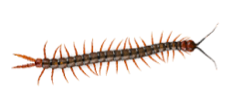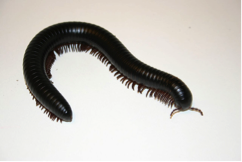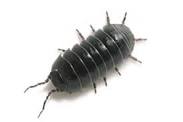 centipede
centipede millipede
millipede
Centipedes/Millipedes
Millipedes and centipedes are similar pests. Though they may be unusually repulsive, they are not a major threat to people or animals.
They can grow up to six inches in length. A centipede can be easily distinguished from a millipede because it has fewer legs; specifically, one set for every segment of its body. Millipedes have two sets of legs for every segment, and when they move, their legs appear to be moving in a wave-like motion. A millipede's legs are also shorter and, in general, a millipede cannot move very fast. A centipede, with its fewer legs, can travel considerably faster.
Both centipedes and millipedes are generally hatched from eggs, but some varieties are born live. Some centipedes may live as long as six years.
Centipedes actually have the ability to bite, and are poisonous. The poison from their fangs, located behind the head, is used to kill insects, which are their primary food. To a human, a bite feels like that of a bee sting, and can be dangerous, especially if there is an allergic reaction in response to the bite. Children will be more sensitive to a centipede's bite.
House centipedes are an indoor variety. They can move quickly and do not require the moisture that the other varieties need. Centipedes are beneficial to the control of other insects, which may be a good reason to keep them around. The most likely time of year to see centipedes in your home is in the spring or fall.
 Pill BugsPill Bugs
Pill BugsPill Bugs
Pill bugs get their name from their habit of curling into a ball when they are disturbed. Some people call them “roly polies” for the same reason. There are pill bugs throughout the world. The most common pill bug in the United States is Armadillidium vulgare (Latreille).
Despite the name, pill bugs are not really bugs. They are land-dwelling crustaceans in the order Isopoda.
Pill bugs usually live in areas where there is high moisture. Their bodies do not hold water. Because of that, they stay hidden during the day and are active at night. They commonly live under landscape timbers and flowerbed mulch. It is common to find them under flowerpots and trashcans.
Pill bugs are scavengers. They eat decaying plant material. They sometimes damage young plants. They also eat animal material if they find it.
Pill bugs often invade homes through sliding glass doors and other ground-level entrances. They also enter garages and storage buildings.
Pill bugs do not bite people. They do not damage household items or deposit eggs indoors. Often, the indoor environment is too dry for them and they die after coming inside.
The first step in preventing pill bugs is reducing the moisture around the home. Mulch in flowerbeds should be no deeper then 2 in. Homeowners should pull mulch away from the home’s foundation. A “dry zone” of 6 to 12 inches around the foundation will discourage pill bugs and other pests.
Firewood should be stacked off the ground. It should be as far away from the house as possible. Flowerpots should be on racks or stands off the ground. Gutters and downspouts should drain away from the foundation. It may be necessary to trim tree limbs if they cause a damp shady area near the home.
Treatment
Perimeter Spray Treatment - We spray a residual insecticide treatment around all entry points and the perimeter of your house.
Indoor Spray Treatment – We spray in all crack and crevice along baseboards, window and door frames, corners, pipes and other areas where Centipedes/ Millipedes and Pill Bugs may crawl.
Treatment for Centipedes/ Millipedes and Pill Bugs can includes an inside and/or outside. All pets need to be out the treatment area for no less than 4 hours, including birds. Fish Tanks need to be covered and pump turned off. Heat/AC need to be turned off during treatment and for 4 hours after treatment so chemical can settle.
